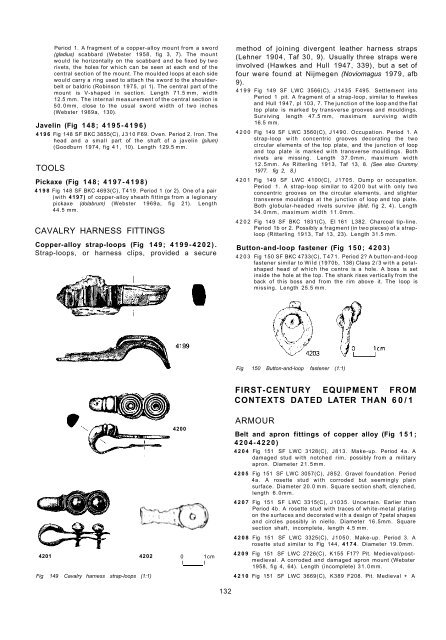Colchester Archaeological Report 2: The Roman small finds
Colchester Archaeological Report 2: The Roman small finds
Colchester Archaeological Report 2: The Roman small finds
You also want an ePaper? Increase the reach of your titles
YUMPU automatically turns print PDFs into web optimized ePapers that Google loves.
Period 1. A fragment of a copper-alloy mount from a sword<br />
(gladius) scabbard (Webster 1958, fig 3, 7). <strong>The</strong> mount<br />
would lie horizontally on the scabbard and be fixed by two<br />
rivets, the holes for which can be seen at each end of the<br />
central section of the mount. <strong>The</strong> moulded loops at each side<br />
would carry a ring used to attach the sword to the shoulderbelt<br />
or baldric (Robinson 1975, pl 1). <strong>The</strong> central part of the<br />
mount is V-shaped in section. Length 71.5 mm, width<br />
12.5 mm. <strong>The</strong> internal measurement of the central section is<br />
50.0mm, close to the usual sword width of two inches<br />
(Webster 1969a, 130).<br />
Javelin (Fig 148; 4195-4196)<br />
4196 Fig 148 SF BKC 3855(C), J310 F69. Oven. Period 2. Iron. <strong>The</strong><br />
head and a <strong>small</strong> part of the shaft of a javelin (pilum)<br />
(Goodburn 1974, fig 41, 10). Length 129.5 mm.<br />
TOOLS<br />
Pickaxe (Fig 148; 4197-4198)<br />
4198 Fig 148 SF BKC 4693(C), T419. Period 1 (or 2). One of a pair<br />
(with 4197) of copper-alloy sheath fittings from a legionary<br />
pickaxe (dolabrum) (Webster 1969a, fig 21). Length<br />
44.5 mm.<br />
CAVALRY HARNESS FITTINGS<br />
Copper-alloy strap-loops (Fig 149; 4199-4202).<br />
Strap-loops, or harness clips, provided a secure<br />
4201 4202<br />
Fig 149 Cavalry harness strap-loops (1:1)<br />
4200<br />
0 1cm<br />
I I<br />
132<br />
method of joining divergent leather harness straps<br />
(Lehner 1904, Taf 30, 9). Usually three straps were<br />
involved (Hawkes and Hull 1947, 339), but a set of<br />
four were found at Nijmegen (Noviomagus 1979, afb<br />
9).<br />
4199 Fig 149 SF LWC 3566(C), J1435 F495. Settlement into<br />
Period 1 pit. A fragment of a strap-loop, similar to Hawkes<br />
and Hull 1947, pl 103, 7. <strong>The</strong> junction of the loop and the flat<br />
top plate is marked by transverse grooves and mouldings.<br />
Surviving length 47.5 mm, maximum surviving width<br />
16.5 mm.<br />
4200 Fig 149 SF LWC 3560(C), J1490. Occupation. Period 1. A<br />
strap-loop with concentric grooves decorating the two<br />
circular elements of the top plate, and the junction of loop<br />
and top plate is marked with transverse mouldings. Both<br />
rivets are missing. Length 37.0mm, maximum width<br />
12.5mm. As Ritterling 1913, Taf 13, 8. (See also Crummy<br />
1977. fig 2, 8.)<br />
4201 Fig 149 SF LWC 4100(C), J1705. Dump or occupation.<br />
Period 1. A strap-loop similar to 4200 but with only two<br />
concentric grooves on the circular elements, and slighter<br />
transverse mouldings at the junction of loop and top plate.<br />
Both globular-headed rivets survive (ibid, fig 2, 4). Length<br />
34.0mm, maximum width 11.0mm.<br />
4202 Fig 149 SF BKC 1831(C), El 161 L382. Charcoal tip-line.<br />
Period 1b or 2. Possibly a fragment (in two pieces) of a straploop<br />
(Ritterling 1913, Taf 13, 23). Length 31.5 mm.<br />
Button-and-loop fastener (Fig 150; 4203)<br />
4203 Fig 150 SF BKC 4733(C), T471. Period 2? A button-and-loop<br />
fastener similar to Wild (1970b, 138) Class 2/3 with a petalshaped<br />
head of which the centre is a hole. A boss is set<br />
inside the hole at the top. <strong>The</strong> shank rises vertically from the<br />
back of this boss and from the rim above it. <strong>The</strong> loop is<br />
missing. Length 25.5 mm.<br />
Fig 150 Button-and-loop fastener (1:1)<br />
FIRST-CENTURY EQUIPMENT FROM<br />
CONTEXTS DATED LATER THAN 60/1<br />
ARMOUR<br />
Belt and apron fittings of copper alloy (Fig 151;<br />
4204-4220)<br />
4204 Fig 151 SF LWC 3128(C), J813. Make-up. Period 4a. A<br />
damaged stud with notched rim, possibly from a military<br />
apron. Diameter 21.5mm.<br />
4205 Fig 151 SF LWC 3057(C), J852. Gravel foundation. Period<br />
4a. A rosette stud with corroded but seemingly plain<br />
surface. Diameter 20.0 mm. Square section shaft, clenched,<br />
length 6.0mm.<br />
4207 Fig 151 SF LWC 3315(C), J1035. Uncertain. Earlier than<br />
Period 4b. A rosette stud with traces of white-metal plating<br />
on the surfaces and decorated with a design of ?petal shapes<br />
and circles possibly in niello. Diameter 16.5mm. Square<br />
section shaft, incomplete, length 4.5 mm.<br />
4208 Fig 151 SF LWC 3325(C), J1050. Make-up. Period 3. A<br />
rosette stud similar to Fig 144, 4174. Diameter 19.0mm.<br />
4209 Fig 151 SF LWC 2726(C), K155 F17? Pit. Medieval/postmedieval.<br />
A corroded and damaged apron mount (Webster<br />
1958, fig 4, 64). Length (incomplete) 31.0mm.<br />
4210 Fig 151 SF LWC 3669(C), K389 F208. Pit. Medieval + A

















